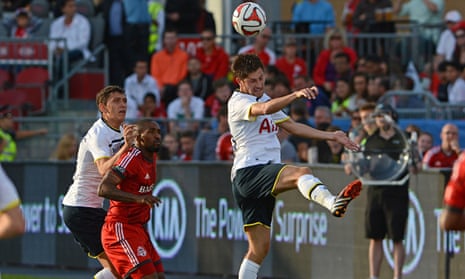When Neil Taylor fractured his ankle against Sunderland back in September 2012, the concern at Swansea City extended beyond the Welshman’s personal torment. The transfer window had closed less than 24 hours earlier and Swansea’s only other left-back was Ben Davies, a teenager who had six minutes of league football to his name. Michael Laudrup, Swansea’s then manager at the time, surveyed what he had seen when Davies came on against Sunderland and accepted that he needed to bring in an experienced free agent.
“Ben did well and he had a great pre-season but he is only 19, we can’t put that much responsibility and pressure on him,” Laudrup said after the 2-2 draw with Sunderland. Little more than a week later, Swansea announced that Dwight Tiendalli, a former Holland Under-21 international who had been released by FC Twente, had joined on a free transfer. Davies had enjoyed a taste of first-team action and that was the last we would see of him for a while. At least that was the theory.
The reality turned out to be rather different. Laudrup selected Davies for the first match after the international break, a 2-0 defeat at Aston Villa and, to the Dane’s credit, kept faith with him for the remainder of the season. Davies flourished, visibly growing in confidence with each game he played, so much so that Tiendalli was reduced to being a bit-part player. It has been a meteoric rise for Davies ever since, culminating in this week’s £10m swap deal with Gylfi Sigurdsson at Tottenham Hotspur, where the 21-year-old will be Mauricio Pochettino’s first-choice left-back.
Not bad for someone who was turning up for first-team games at Swansea in his Volkswagen Polo, complete with wind-down windows – a source of amusement among the rest of the squad – less than two years ago. Davies had not long graduated from the youth team and was earning around £400 a week at the time. His salary at White Hart Lane is likely to have a couple more zeros on the end.
For Davies, it must feel as though the last two years have passed by in a blur. He has been a man in a hurry. Four weeks after making his first Premier League start, he was filling Taylor’s boots for country as well as club, making his Wales debut in the 2-1 win over Scotland in October 2012. The following month he signed a three-and-a-half-year contract at the Liberty Stadium as reward for his progress.
His first senior goal arrived against Stoke in January last year and encapsulated what Davies is all about.
Picking up the ball just inside his own half, he played a give-and-go, continued his run and brushed off the challenge from Jon Walters when possession was returned to him on the edge of the penalty area. He then slipped away from Ryan Shawcross, evaded Robert Huth and dispatched a low shot into the corner of the net.
Davies struck twice in the Premier League last season, including a superb left-footed volley at The Hawthorns at the start of September, yet he is a defender first and foremost – not a full-back waiting to be converted into a left-winger (similarities with Gareth Bale are confined to their nationality and favoured foot).
Indeed, Laudrup wondered whether Davies would end up as a left-sided centre-half later in his career. At 1.81m (5ft 11in), he probably lacks a bit of height to play in the middle of defence. He is also, by his own admission, not blessed with great pace. Not that he suffers as a result.
Davies reads the game well, he has a lovely left foot and is technically strong. There is nothing flamboyant about him; he is composed in possession and uses the ball intelligently. He made more successful passes than any other left-back in the Premier League last season (admittedly, Swansea’s style of play contributes to that statistic) and his first instinct is always to try to play forward, rather than go sideways and look for the safe option. He also possesses a decent strike.
In December last year, when Davies signed a one-year extension that tied him to Swansea until 2017, Laudrup spoke as if he knew what was around the corner. “[Ben] has already done a lot but every day in training he wants to improve. He doesn’t think he has arrived and that is the right attitude. I am sure one day – although it may not be good news for Swansea – we will see Ben at one of the top five or six clubs in the Premier League.”
In an ideal world Swansea would have kept hold of Davies, who was born in Neath and came through their academy, but they were resigned to the fact that his head had been turned once Tottenham made it clear they were serious about signing him. From that point on it was a case of trying to make the best of a bad situation, which is why Swansea pushed so hard for Sigurdsson, who excelled at the Liberty Stadium during a loan spell a couple of years ago, to be part of the deal.
Comparisons between Davies and Luke Shaw, another young and talented British left-back on the move this summer, are inevitable. Although they broke through into the first team at pretty much the same time, Shaw, at 19, is two years younger than Davies. The England international cost Manchester United an initial £27m, which is three times as much as the Welshman was valued at – something that has aggrieved Swansea supporters, who feel Spurs are getting Davies on the cheap.
Although Shaw has yet to score a senior goal, the England international is a more natural attacker than Davies; at times at Southampton he was operating so far forward that he was playing almost as a winger. Last season Shaw delivered 142 crosses from open play for Southampton from 35 Premier League games; Davies made 75 from 34 matches for Swansea. That said, both players ended up with one assist to their name.
Perhaps the biggest compliment to Davies is that Taylor’s absence, which threatened to leave a huge void, almost went unnoticed at Swansea. Taylor, it is easy to forget, was one of the most highly rated left-backs in the Premier League prior to his injury. He had enjoyed an impressive first season in the top flight, under Brendan Rodgers, represented Team GB at the 2012 Olympics and was attracting interest from the Premier League’s leading clubs. Yet two years on it is Davies who is heading for the bright lights while Taylor prepares to rebuild his career at Swansea.
Some may say that fate has been kind to Davies, who got his opportunity courtesy of a team-mate’s misfortune. It is one thing, though, to be in the right place at the right time, and quite another to seize a chance when it presents itself. Davies did that and more over the past two seasons. He may not be a sexy name and could probably walk through the streets of north London without anyone batting an eyelid, but if his career continues on the same trajectory, Spurs will have an accomplished player on their hands for years to come.

